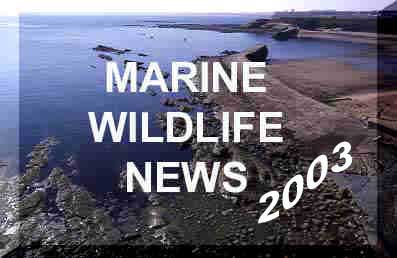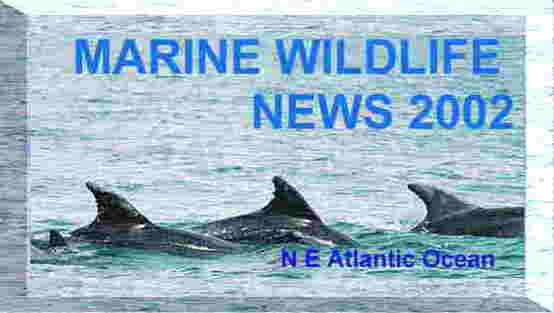
|
|
|
|
|
(BMLSS *** Site) |
|
|
|
Norwegian Marine*** |
|
L-I-N-K-S to Other Sites (Click on Text) |
|
Smart Group |
 |
|
|
|
|
|
|

AUTUMN 2004
Reports of marine wildlife from all around the British Isles, with pollution incidents and conservation initiatives as they affect the fauna and flora of the NE Atlantic Ocean.
on Microsoft Internet Explorer (best) or Netscape
 |
 |
 |
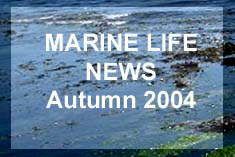 |
LATEST NEWS:
WILDLIFE REPORTS AND NEWS
8 December 2004
NB: This species of dolphin is not often recorded in the eastern English Channel.
A pod of seven White-beaked Dolphins, Lagenorhyncus albirostris, off Dungeness, Kent. They gave a spectacular display including leaping clear of the water as they fed and were in view for most of the afternoon. I have looked at the sea on an almost daily basis at Dungeness since 1989 and this is the first time I have seen White-beaked Dolphins.
BMLSS Cetacea7 December 2004
Commercial fisherman Andy Le Prevost trawling on the Lady Patricia caught a Almaco Jack, Seriola rivoliana, (originally identified as a Guinean Amberjack, Seriola carpenteri), on the south-west Casquet bank, near the Channel Islands, at night.
ID DetailsThe fish was caught at a water depth of 25 metres. The fish was small (length: 30.7 cm, weight: 637 grams) and similar in size to the specimen caught by George Staples east of Herm Island on 7 September 2000. The sea temperature was 11.7°C. My records indicate that this is the fourth confirmed Amberjack species caught in Channel Island waters.
Full Details
Previous RecordReport and Photograph by Richard Lord (Guernsey)
on the Marine Wildlife of the North-east Atlantic Ocean Group
6 December 2004
A 40 cm long Oriental Flying Gurnard, Dactyloptena orientalis, was hauled up in a herring net less than a mile from Penzance. The fish is being kept at the Blue Reef Aquarium in Newquay after skipper Tony Richards, from St. Ives, kept it alive.Flying Gurnard
Photograph by Jim Greenfield (taken in Gozo)“We were in only about 15 metres depth and were hauling up our herring nets by hand. It was the last fish in the net. I could feel by touching that it was an extraordinary specimen — its skin is armoured. It had a flat head and when I picked it up it spread its wings. They are as wide as the fish is long, about 40 cm.
“It is a beautiful animal. Its wings are all different colours: blue, red, yellow and grey. I’ve never seen anything like it in all my years at sea. It’s an incredible beast.”Report from Times On-LineThis southern species of gurnard has only been recorded on one or two occasions off British coasts, both if them off the coast of Cornwall.1 December 2004
Guernsey commercial fisherman Steve Fallaize landed a handsome Couch's Sea Bream, Pagrus pagrus, on weighing 2688 grams whole (5.93 lb). The fish was netted in a water depth of about 20 to 25 metres over a mixed shell-gravel bottom off Guernsey's west coast.This is the largest Couch's Sea Bream that I have recorded in Guernsey.Small Couch's Sea Bream have been frequently landed in recent years around the Channel Islands, but this is a southern fish and it is uncommon any further north.
Report and Photograph by Richard Lord (Guernsey)
on the Marine Wildlife of the North-east Atlantic Ocean GroupBMLSS Nudibranchs
28 November 2004
The record of the miniature nudibranch Doto maculata from Loch Fyne (a sea loch on west coast of Scotland) at depth of 16 metres could be because this small mollusc is rarely recorded rather than being uncommon. The problem is that it could be confused with other sea slugs of the same genus, especially the common species Doto coronata.16 November 2004
A commercial fisherman gill netted a 15 cm long Tadpole Fish, Raniceps raninus, off the Pea Stacks on Guernsey's south coast. This is a solitary rather than an unusual fish from around the Channel Islands and all my Guernsey records for this species occur between November and early April.Report by Richard Lord (Guernsey)
Fin Whale washed in by the gales and stranded dead
on Aires Point, near Sennen Cove, Cornwall
Photographs by Jane HerbertA second 15 metres long Fin Whale, Balaenoptera physalis, was discovered washed dead on the rocky shore at Aires Point near Sennen Cove (near Land's End) on the Cornish coast. The female whale showed a definite series of injuries. Although intact it was beginning to whiff a bit.
Report by Vince Smith on the Cornish Mailing ListBBC News Report
Cornish Marine Wildlife News
Fin Whale Stranding Picture Portfolio
BMLSS Cetacea
30 October 2004
Gales battering the south and west of England have washed along a container of Goose Barnacles, Lepas, as far as Hayling Island (Hampshire) which east of the Isle of Wight.Report and Photographs by George EastBMLSS Seahorse Page

A Whiting was caught on rod and line four miles out of Brighton, Sussex, and it promptly regurgitated a Seahorse, Hippocampus sp. Seahorses are not known off the Sussex coasts, although I have received at least one unconfirmed sighting before. This is probably the Short-snouted Seahorse, Hippocampus hippocampus. (It is usually the shallow water species Hippocampus guttulatus that has been recorded off the Dorset coast.)
Seahorse Trust
Seahorse SurveyBoth species of seahorses recorded from British seas have been recommended by English Nature for full protection under under the Wildlife and Countryside Act (1981). This will be subject to public consultation.
29 October 2004
A 15 metres long Fin Whale, Balaenoptera physalis, was discovered washed up dead on the shore of St Mary Bay, near Brixham (near Torquay), in south Devon. The shape of the huge sea mammal was still intact enabling it to be recognised easily.Report by Vince Smith on the Cornish Mailing ListBBC News Report27 October 2004
Cornwall is battered by gales and torrential rain causing floods, whereas many parts of England escaped this awful weather. The Newquay Weather Station registered Force 7 gusting to Force 9.
Beaufort Scale
BBC News Report
Photographs9 October 2004
A visit to three shores in northern Cornwall brought the first report of a Violet Snail, Janthina janthina, with the recent spate of By-the-wind Sailors, Velella velella, strandings. Two shells, one alive and one dead, discovered by Julie Hatcher (Kimmeridge Bay Marine Nature Reserve) on Widemouth Bay beach, near Bude. The strandline was covered in the white skeleton shells of Velella several centimetres thick.
Not only the shell but the soft body of the Violet Snail is also a violet colour. This gastropod feeds of on Velella and secretes a mucus bubble-raft to keep in buoyant. Another animal (a crustacean) that secretes a polystyrene-like raft to keep it afloat is the Buoy Barnacle, Dosima fascicularis, which were present in their hundreds and were still be swept in on to the beach to strand and die. These were more numerous than at least two species of Goose Barnacles, the commonest was Lepas anatifera and the other smaller one washed up was the Duck Barnacle, Lepas pectinata. These two barnacles are always attached to floating debris and are not pelagic, but sessile animals when adult and they become stranded on the shore when the object they attach themselves to becomes dislodged and floats away.Report by Steve TrewhellaBMLSS Barnacles5 October 2004
A 347mm TL (315mm FL) Guinean Amberjack, Seriola carpenteri, was caught by Lee Allen and Gary Cann from a boat close to La Corbiere Lighthouse (SW Coast of Jersey) in a gill net, set in depth of 15 metres over sand and a shallow reef. Fin & Feather of St Helier Fishmarket brought this unusual capture to my notice. This sub- tropical fish has only been recorded twice before in the Channel Islands and has not been recorded on the northern side of the English Channel. The very first capture was in September 2000, with theidentification confirmed by Alwyn Wheeler at the Natural History Museum (London). This new record is not yet confirmed.NB: Care must be taken to avoid confusion with the Amberjack, Seriola dumerili, which the original fish was originally identified as, and this is also a rare vagrant fish form southern seas.
October 2004
The Warty or Yellow Crab, Eriphia verrucosa (= E. spinifrons), was discovered off the Cornish coast and it has found a home in the National Aquarium at Plymouth. This appears to be the first record in British waters of this little known (in England) crab that inhabits southern seas from Brittany (France) to Mauritania (north Africa), and with a widespread distribution in the Mediterranean, so it is surprising that vagrant crabs have not appeared before.Report from Doug Herdson (National Marine Aquarium, Plymouth)
September - October 2004
Young Triggerfish, Balistes capriscus, 10 cm long, have been caught from Weymouth Pier. This may prove, or at least give a very strong indication, that they are breeding off Dorset.Report from Doug Herdson (National Marine Aquarium, Plymouth)
on the Marine Wildlife of the North-east Atlantic Ocean Group25 September 2004
A 20 metres long, 30 tonne, Fin Whale, Balaenoptera physalis, was washed up dead on the mud flats at St Brides, West Usk, in south Wales, near Newport on the shores of the Bristol Channel.
18-25 September 2004
The massive stranding of By-the-wind Sailors, Velella velella, has now been established that it has stretched much further than just the Cornish coast and that the numbers were in billions. Reports of large numbers of large specimens and huge numbers occurred all along the Welsh coast as far north as Anglesey and almost certainly further north as well.Velella on Constantine Bay beach, north Cornwall
Photograph by Amanda BertuchiSome Reports:
24 September 2004
Thousands of Velella were washed up at Woolacombe, north Devon in unprecedented numbers, estimated up to 200 a square metre!Report by David Jenkins via Gavin BlackAt Westwood Ho!, north Devon Velella are two or three inches (50 - 75 mm) thick on the shore.
Devon Biodiversity Records Centre (DBRC)
c.18 September 2004
Several hundred By-the-wind Sailors arrived on the beach on the Isle of Islay, west Scotland. The flesh rotted away quite quickly.Report by Malcolm Ogilvie on UK Wildlife Yahoo GroupEarly September 2004
16 September 2004
Velella were found on the shore between Newquay in Wales and Aberaeron with a length of 60 mm +. There was one every three metres or so around the rocks at Cei Bach thinning out in the sand areas. All were strikingly large compared to those I have found before in south Wales and Cornwall before. All had soft tissue and colour but were dead and disintegrating.
We found large amounts of Velella velella out off the Pembrokeshire coast back at the start of September and the ensuing storms seem to have deposited many of them on our beaches in the west of Pembrokeshire (at least). Their small size make them easy to overlook at sea and also on dark sand but they are exquisite jewel like creatures.
21-23 September 2004First strandings on Velella on the sandy beach at Polzeath, Cornwall
Photograph by Jonathan Smith
All reports by Andy Horton unless the credits are given to other observers or reporters.
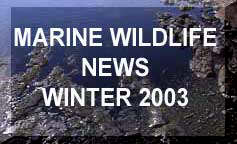 |
 |
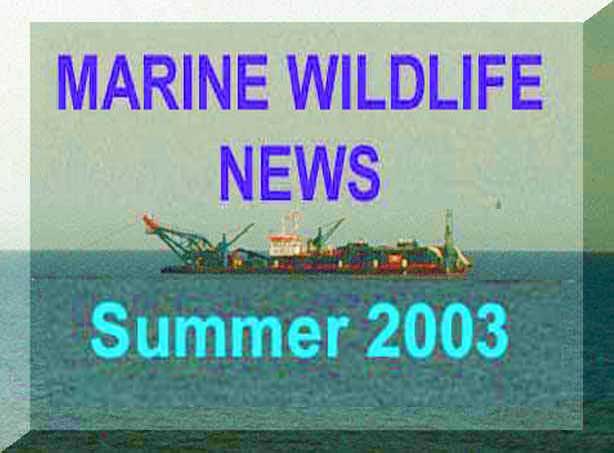 |
 |
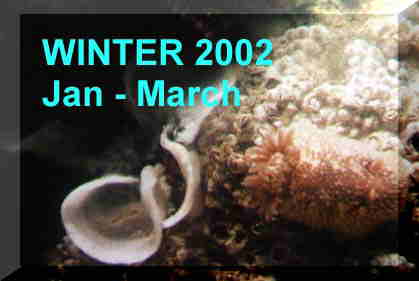 |
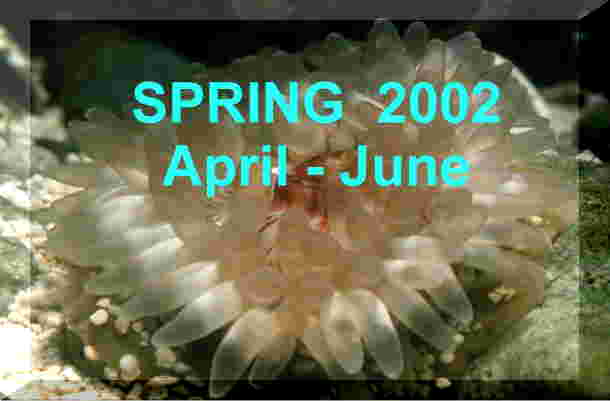 |
 |
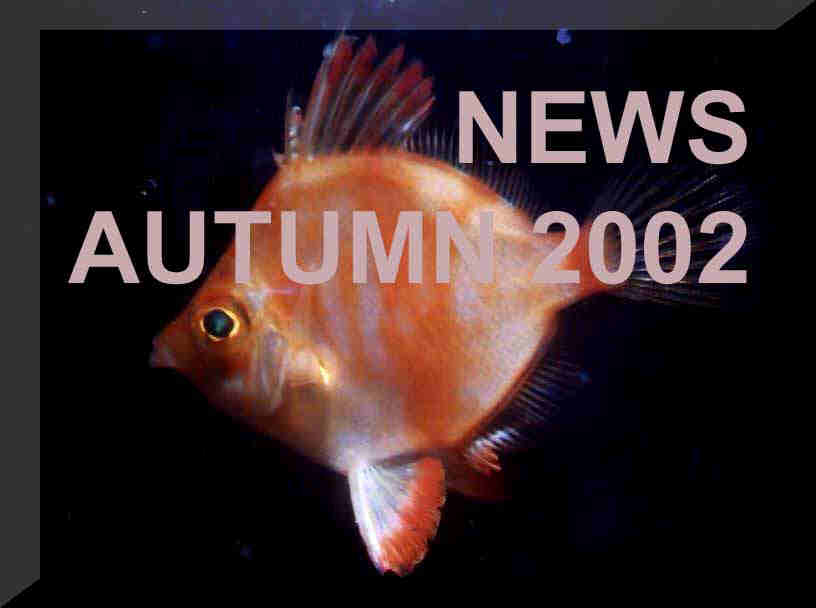 |
FOR EARLIER REPORTS CLICK ON THE BUTTON BELOW

The Marine Wildlife of the NE Atlantic Forum commences.
PLEASE JOIN

MARINE WILDLIFE of the NE ATLANTIC EFORUM PAGE (LINK TO)
Nature Notes Webring
News 2002
News 2001
News 2000
News 1999
|
Use these links if your are familiar with the scientific classifications of marine life |
The BMLSS (England) site commenced on 1 January 1997.
|
|
 |
 |
Andy Horton, Webmaster
|
|
|
|
|
|
Membership Form |
News 2001 News 2000 |

